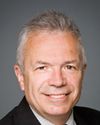Thank you, Mr. Chair and honourable members of Parliament.
Thanks very much for the honour of appearing here today. It is my pleasure to discuss the North American Aerospace Defence Command, and Canada's contribution to the defence of North America in cooperation with the United States.
Our NORAD mission, in simple terms, is to watch the skies above our continent, and be ready to quickly and effectively respond to imminent security threats. NORAD is a binational Canada-U.S. command that continuously provides detection, validation, and warning of air-breathing threats to our continent, and appropriate aerospace defence measures to respond to hostile actions against North America. As part of our NORAD envelope of responsibilities, your Royal Canadian Air Force maintains the highest readiness levels of any command within the Canadian Armed Forces; therefore, RCAF readiness is fundamental to NORAD readiness.
As we speak, some 430 servicemen and women from the Canadian Armed Forces and the U.S. Air Force monitor the aerospace approaches to Canadian territory, identify all tracks in and around Canadian airspace, and stand ready to intercept and control aircraft that may be of concern to Canadian and North American security. Based at the operational headquarters for the Royal Canadian Air Force in Winnipeg, Manitoba, the Canadian NORAD region, or CANR, is one of the three NORAD regions. The other two regional headquarters are located at Elmendorf Air Force Base in Alaska, and Tyndall Air Force Base in Florida.
Since the terrorist attacks of 2001, CANR has been heavily committed to Operation Noble Eagle, NORAD's ongoing internal air defence mission. As part of Operation Noble Eagle, we monitor all domestic air traffic and respond to virtually any airborne threat that may put Canadians in harm's way. As commander of 1 Canadian Air Division, I am responsible for providing CANR with combat-ready air forces to meet Canada's commitment to the defence of North America and maintaining the sovereignty of our continent's airspace.
Our posture is scalable depending on threat levels. In peacetime, most of our people are located in Winnipeg, where the air division headquarters is situated; at 22 Wing North Bay, where the Canadian air defence sector headquarters is located; and our two fighter force wings in Bagotville, Quebec, and Cold Lake, Alberta. Our country's vastness requires our two fighter wings to additionally rely on deployed operating bases and forward operating locations scattered across the country, including the north. These auxiliary locations extend the reach of our fighters by providing forward areas for basing, refuelling, and maintenance. To ensure our forward operating locations are capable and ready, we routinely conduct exercises and operate out of them. One such example was Operation Spring Forward in April 2014, which was the largest deployment to our forward operating locations since the end of the Cold War. This exercise involved Canadian and Alaskan NORAD assets working in coordination to enhance our interoperability.
Over and above our infrastructure requirements, which include our network of radars, our CF-18 Hornets also rely on support from NORAD air-to-air tankers during extended missions. Tankers and their associated crews and squadrons, of course, encompass several additional infrastructure staffing and logistical requirements, which are essential to NORAD operations.
NORAD is far more than a close working relationship between the U.S. and Canada. Rather, it is a full-fledged binational command, and arguably the world's most intimate military arrangement between two allies. It's effectively nurtured by professionals from the Canadian and U.S. militaries working in lockstep at our respective headquarters 24 hours a day and 365 days a year to help keep our two countries safe from potential threats.
As you may know, USAF personnel within Canada serve under my command. If you've been to our headquarters in Winnipeg, you know that beside my office is the office of the USAF general who serves as my deputy commander for operations. By virtue of the NORAD agreement, Brigadier-General Hyde is an integral part of the RCAF force employment planning and execution. In much the same way, our Canadian general serves as a deputy commander of the NORAD headquarters at Peterson Air Force Base in Colorado Springs.
A well-known illustration of how our integration works is that on 9/11, it was none other than the Canadian general in Colorado Springs, working as the duty commander, who orchestrated the scramble of U.S. Air Force jets in response to that crisis. Lieutenant-General Ken Pennie held command over U.S. personnel and assets in the same way the USAF general in Winnipeg commands our personnel when he is on duty.
As part of our interoperability, we regularly exchange NORAD-related intelligence and resources as well. This allows our two countries to share the burden of responding to emerging airborne threats, depending on the availability of resources on both sides of the border.
Examples of our reciprocity include when two Canadian-based CF-18 fighters intercepted and visually identified two Russian Bear long-range bombers flying in international airspace north of Alaska, or when two U.S. F-15s out of Portland, Oregon, responded to an air emergency near Vancouver in 2012.
Most recently, U.S. Air Force personnel and aircraft deployed to 5 Wing Goose Bay in Labrador for Exercise Vigilant Shield, where together we practised a variety of defence scenarios.
Our enduring alliance with the U.S. is something my colleagues and I actively practise on a daily basis. Canadians who believe international cooperation brings peace and stability can regard NORAD with pride. But pride in our alliance demands also a measure of vigilance. The global security landscape continues to evolve rapidly, which is why NORAD's force posture is now routinely reviewed. Our force posture must have the capability to engage a variety of symmetric and asymmetric threats.
Symmetric, or state-sponsored threats, are considered the most dangerous. In terms of conventional aerospace warning and control missions that are relevant to my command, the potential threat would be in the form of foreign, long-range aviation and/or bomber fleets.
Given the current geopolitical climate, the probability of a military aviation attack is actually low. Capabilities exist to cause us harm, but there is currently no known intent. In a situation where hostile intent is a reality, this would constitute a threat where strategic warning is measured in minutes to hours, and our ability to react is limited to what we have at hand. This explains the requirement to maintain very high readiness levels, even in peacetime. It also explains why NORAD continuously tracks and responds to numerous aircraft of interest close to the airspaces of Canada and the United States.
Asymmetric threats, in the context of NORAD, are those posed by such activities as terrorist organizations' use of an aircraft. The September 11 attack is of course the most tragic example of this, and these threats remain a valid concern with serious security consequences. As a result, we must be ready for scenarios involving aircraft being used to bring harm to populated areas.
That's why regular operations, such as Operation Noble Eagle, are ongoing exercises to ensure we remain trained and capable to accomplish our mission. Since the terrorist attack on September 11, 2001, when our nations began to place greater emphasis on surveillance and control of Canada and the U.S., NORAD has responded to more than 3,500 possible air threats and intercepted more than 1,400 aircraft in Canada and the United States.
This serves as a fine example of the crucial partnerships we have nurtured with organizations including federal aviation and law enforcement agencies in both of our countries. NORAD's legacy for the past 56 years has been underpinned by unwavering dedication and determination by our professionals. You can expect nothing less from our men and women in the years ahead.
With our collective vigilance, we can ensure the skies above every community across our vast nation remain secure.
Thank you very much.
I look forward to responding to your questions.



